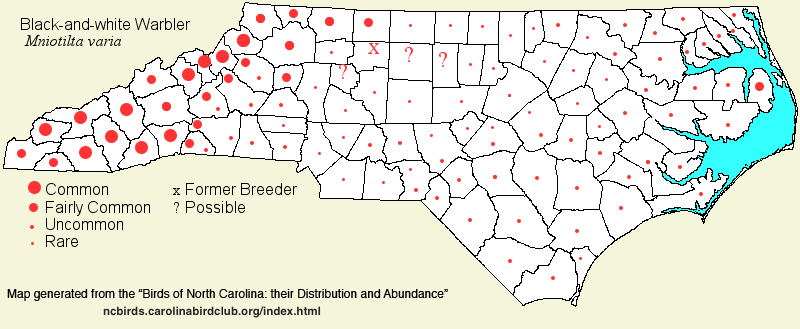 |  |
|
Black-and-white Warbler - Mniotilta varia PARULIDAE Members: | Search Common: Search Scientific: |
|
|
|||||||
| General Comments | The Black-and-white Warbler is literally unique, and deservedly is in its own genus. No other warbler creeps along trunks and limbs, like a nuthatch; yet, despite its life in the trees, it nests on the ground, at the base of a tree. It breeds over most of the eastern United States and much of Canada, and it also winters in small numbers in the southern states. Despite it breeding "across" North Carolina, there are local areas of complete absence, such as much of the Piedmont; thus, it nests mainly in the mountains and Coastal Plain, despite an abundance of suitable habitat in the Piedmont. It winters sparingly along the southern coast, and increasingly remaining into winter farther inland. Breeding habitat is usually in mature upland hardwood forests in the mountains and foothills -- coves, northern hardwoods, and oak-hickory stands; in the Coastal Plain, where mature upland hardwood stands are scarce, they nest mainly in bottomlands but will nest in swamps and nonriverine forests. In a few areas of the state, they nest in mixed hardwood-pine stands. In winter, they favor maritime forests and other broadleaf evergreen trees, often mixed with pines. | ||||||
| Breeding Status | Breeder | ||||||
| NC BRC List | Definitive | ||||||
| State Status | |||||||
| U.S. Status | |||||||
| State Rank | S5B,S1N | ||||||
| Global Rank | G5 | ||||||
| Coastal Plain | Summer resident, transient, and sparse winter resident (mainly near the southern coast). In summer, quite local, generally uncommon to fairly common, more numerous in the northern portions, and can be scarce near South Carolina. Absent as a breeder on the Outer Banks. As a spring and fall migrant, often fairly common throughout (though scarce along the coast in spring). In winter, rare to uncommon along the southern coast (i.e., coastal counties), and rare into early winter in the remainder of the region; overwinters mainly in Brunswick and New Hanover, though many scattered Jan-Feb records elsewhere. Increasing across the region in winter in recent years, and almost certainly some birds overwinter successfully as far inland as the Fall Line. Mainly late Mar to early Nov. Peak counts: | ||||||
| Piedmont | Summer resident, transient, and winter straggler/visitor. In summer, uncommon to locally fairly common in foothill ranges, such as the South and Brushy mountains; rare and local (and likely absent in some counties) elsewhere, except fairly common in Warren (for no obvious reason). Breeding status uncertain in many counties; formerly (1969) considered "uncommon" breeder in Wake, but essentially absent in recent decades. As a transient, generally fairly common to common over the region in both spring and fall. Rare into early winter, though some do make it through the winter; increasing in recent winters. Mainly late Mar to late Oct. Peak counts: | ||||||
| Mountains | Summer resident, with noticeable migratory movements. In summer, generally fairly common, to locally common (though has slightly declined) over most of the region, up to about 5,000 feet, and sparingly to 5,500 feet. Widespread transient; fairly common. Accidental in winter: 1, Crumpler (Ashe), 18 Dec 1967. Mainly early Apr to mid-Oct. Peak counts: | ||||||
| Finding Tips |
The species should be seen in small numbers on a morning of birding in most of the mountains in spring and early summer, especially in late Apr. It is a bit more local in the Coastal Plain as a breeder. *** | ||||||
| Attribution | LeGrand[2023-04-03], LeGrand[2021-05-17], LeGrand[2020-04-18] | ||||||
| NC Map Map depicts all counties with a report (transient or resident) for the species. | Click on county for list of all known species. |
| NC Breeding Season Map Map depicts assumed breeding season abundance for the species. |  |